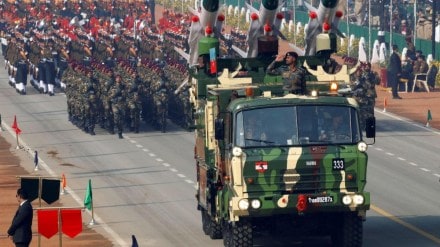India’s defence budget for 2025-26 has been increased by 9.53 percent, bringing the total allocation to Rs 6.81 lakh crore. While this steady expansion reinforces India’s commitment to military modernization, it remains far below the budgets of the United States ($849.8 billion) and China ($232-309 billion, estimated). The contrast underscores the strategic challenges India faces from maintaining deterrence against China and Pakistan to pursuing self-reliance in defence production amid global technological competition.
A Disparity in Scale: Defence Budgets in Numbers
India’s 9.53 percent Defence Budget Hike in Perspective
India’s Rs 6.81 lakh crore budget marks a substantial jump over the previous year’s allocation. This 9.53 percent increase is the sharpest in recent years, reflecting the government’s emphasis on border security, military modernization, and self-reliance in defence production. The capital expenditure component, which funds new acquisitions, has also seen a proportional rise, signaling continued investments in fighter jets, naval warships, and indigenous missile systems.
Despite this, India’s defence budget remains a fraction of what the US and China allocate:
The disparity highlights India’s need to optimize resources, prioritize indigenous innovation, and balance conventional and next-generation warfare investments.
Defence Spending as a Share of GDP
United States: ~3.2% of GDP
India: 1.9-2% of GDP (following the increase)
China: Officially ~1.5% (real figures could be higher)
While India’s military expenditure as a share of GDP is higher than China’s official figures, Beijing’s dual-use investments in civil-military technology, strategic infrastructure, and state-backed defence enterprises suggest that China’s real military funding is significantly higher than stated.
How the three compare: priorities and allocations
United States: Sustaining global military supremacy
With $849.8 billion in military funding, the US remains the world’s largest defence spender, emphasizing technological superiority and global force projection.
Key allocations include:
$49.1 billion for nuclear triad modernization; $48.1 billion for naval and shipbuilding; $61.2 billion for air dominance, including next-generation fighter jets and UAVs; significant investments in AI-driven warfare, cyber capabilities, and hypersonic missile development.
The US military’s focus remains on power projection, alliances like NATO and AUKUS, and maintaining deterrence against China and Russia.
China: Expanding military reach and technological edge
China’s 7.2% defence budget growth is driven by its ambition to dominate the Indo-Pacific and deter US intervention in Taiwan.
Key spending areas include:
Hypersonic weapons, AI warfare, and space-based military systems; Aircraft carrier expansion and blue-water naval capabilities; Cyber warfare and electronic warfare capabilities; Upgrading military infrastructure along the India-China border.
Notably, China’s military-industrial complex is deeply integrated with its broader technological ecosystem, allowing off-the-books defence investments through civilian enterprises and infrastructure projects.
India: Strengthening Border Security and Indigenous Defence
India’s Rs 6.81 lakh crore budget reflects a balanced approach between modernization, deterrence, and self-reliance.
Key focus areas include:
Rs 1.9 lakh crore in capital expenditure for new acquisitions and technological upgrades; Border infrastructure expansion to counter China’s growing presence along the LAC; indigenous production under AatmaNirbhar Bharat, reducing dependency on foreign imports; strengthening naval capabilities in the Indo-Pacific, focusing on submarines, aircraft carriers, and UAVs; expanding missile capabilities, including the Agni and BrahMos series.
Despite the budgetary hike, India still faces a significant gap in funding compared to China and the US, requiring strategic prioritization and efficiency in defence spending.
India’s Challenge: Doing more with less
Managing Resource Constraints
Unlike the US and China, India must balance defence spending with economic development needs. The 9.53 % increase is significant, but it must be allocated effectively to maximize military capability without straining fiscal resources.
Reducing dependence on imports
India remains one of the world’s largest arms importers, relying on Russia, France, and the US for advanced weaponry. While Make in India initiatives have led to progress, India still faces delays in domestic production and capability gaps in critical technologies.
Balancing Conventional and Next-Gen Warfare
Unlike the US, which prioritizes technological superiority, or China, which integrates military expansion with economic growth, India must prepare for both conventional and asymmetric threats.
The budget must accommodate:
High-altitude warfare capabilities against China
Counter-terror operations along the western front
Naval expansion in response to China’s Indo-Pacific ambitions
Cyber and space-based defence investments
India’s strategic imperative
India’s 9.53 % increase in defence spending is a clear signal of intent but it must be matched by efficiency, innovation, and strategic foresight.
Key priorities going forward include:
Accelerating domestic defence manufacturing, reducing reliance on imports
Enhancing joint military production with allies, leveraging partnerships like the US, France, and Israel
Investing in AI, cyber warfare, and space-based defence capabilities, ensuring readiness for future conflicts
Strengthening naval deterrence, as the Indian Ocean emerges as a key strategic theatre
While India’s budget still trails behind China’s growing military spending, the focus must remain on leveraging limited resources to achieve maximum strategic impact. With geopolitical tensions in the Indo-Pacific rising, India’s ability to modernize, indigenize, and optimize defence spending will determine its military strength in the coming decade.
